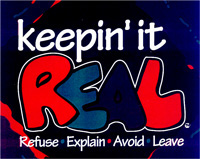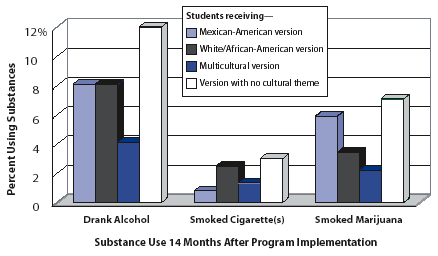A multicultural version of a substance use prevention program tested in middle schools in Phoenix, Arizona, proved at least as effective as culturally targeted versions, according to recent research by Drs. Michael L. Hecht, Michelle Miller-Day, and Flavio Marsiglia and colleagues at Pennsylvania State University and Arizona State University. The NIDA-funded researchers compared a multicultural version of a drug prevention program--which included cultural values from all of the groups participating in the program--to two culture-specific programs. The latter programs are based on the hypothesis that messages matched to the student's culture are more effective than messages that are not culture-specific.
"This is good news for the future of drug prevention in schools serving culturally diverse students," says Dr. Hecht. "It is very difficult logistically to deliver culture-specific programs in culturally diverse schools. Multicultural programs are much easier to deliver, and now we find that they're also as effective as culture-specific programs."
Research has shown that students respond better to drug prevention programs when they see their culture and images of themselves represented in the prevention message. Moreover, minority youth respond favorably to programs that feature a teacher or characters from their own ethnic group.
"We know that kids need to see something of their own lives and cultures reflected in the programs," Dr. Hecht explains. "But we wanted to test the effectiveness of multicultural prevention programs and compare their effectiveness to selectively targeted or matched interventions."

The prevention program, dubbed "keepin' it R.E.A.L.", is a school-based intervention targeting substance use among urban middle schoolers. Its goals are to reduce use of alcohol, cigarettes, and marijuana; promote antidrug norms and attitudes; and develop effective drug resistance decisionmaking and communication skills. Through NIDA funding, "keepin' it R.E.A.L." was developed, tested, and evaluated in 35 middle schools in Phoenix. Designed to reflect aspects of the adolescents' cultures and learning styles in content and format, it includes 10 classroom lessons that promote antidrug norms and teach substance use resistance skills, life skills, risk assessment, and decisionmaking skills. The intervention was reinforced by a public service announcement radio and billboard campaign and by booster activities.

Three versions of the curriculum were created and delivered: one based on Mexican-American culture, one based on African-American and European-American culture, and a multicultural version using five lessons from each of the other two versions. The large proportion of Mexican or Mexican-American students (approximately 74 percent) in the study population contributed to the choice of Mexican-American culture for one curriculum version.
"In developing this program, we studied the process by which kids resisted drugs and used a narrative approach to teach these skills to other kids. The whole program is from youth through youth for youth," observes Dr. Hecht. Stories of drug resistance were collected from adolescents in each ethnic group and used to write scripts for videos that were then performed and videotaped by local high school students. These 10 videotapes (5 for the Mexican-American version, 5 for the African-American/European-American version) form the core of the program. They teach resistance skills through enactments of successful drug resistance in recognizable locales, by youths similar to the students in age and ethnicity.
The lessons' content is built on previous research on what is effective in drug prevention. In addition, researchers infused the curriculum with cultural norms and values that are predominant within certain groups--for example, the value of family to Mexican Americans, respect to African Americans, and individualism to European Americans. Affirming these values can help students use familiar behaviors and attitudes to resist drugs. The curriculum emphasizes family and cultural norms that discourage behaviors like drug use, equipping students with the skills to tap their social support systems to effectively resist drug offers.
"We don't generalize about the cultures. We give them stories. We show them scenarios that come from their mouths. It's always a specific situation, with no moralizing," says Dr. Hecht.
In the fall of 1998, 25 Phoenix middle schools were randomly assigned to one of the three versions of the curriculum, and 10 schools were assigned to the control condition. Schools in the control condition received other drug prevention programs already planned for those schools, including a statewide antitobacco campaign. The research team administered a preintervention survey to all participants and then implemented the curriculum in 7th-grade classes in the 25 treatment schools. Followup surveys were conducted 2 months, 8 months, and 14 months after curriculum implementation. Surveys included questions on demographics; recent alcohol, cigarette, and marijuana use; use of resistance strategies learned in the program; antidrug norms; and intentions to accept substances. The final sample included 6,035 students, of whom 55 percent were Mexican American, 17 percent were non-Hispanic white, 9 percent were African American, and 19 percent were of other Latino or multiethnic Latino origin.
 Multicultural Intervention Had Greatest Impact on Substance Use Initiation. The multicultural version of the intervention program "keepin' it R.E.A.L." had the greatest positive impact on initial substance use over the course of the study, compared to controls and to the culture-specific versions. Students who participated in the multicultural version of the program had the smallest increase in alcohol or marijuana use and the second smallest increase in cigarette use from the initial preintervention survey to the final postintervention survey, 14 months after implementation of the curriculum.
Multicultural Intervention Had Greatest Impact on Substance Use Initiation. The multicultural version of the intervention program "keepin' it R.E.A.L." had the greatest positive impact on initial substance use over the course of the study, compared to controls and to the culture-specific versions. Students who participated in the multicultural version of the program had the smallest increase in alcohol or marijuana use and the second smallest increase in cigarette use from the initial preintervention survey to the final postintervention survey, 14 months after implementation of the curriculum.The results showed that the interventions were significantly more effective than the control condition, with statistically significant effects on the use of gateway drugs (alcohol, tobacco, and marijuana) and on norms, attitudes, and use of resistance strategies. Students participating in any of the three test versions reported better behavioral and psychosocial outcomes related to substance use than did the control students. Although use of alcohol, cigarettes, and marijuana increased over time for both sets of students, the rate of increase was significantly less for students who participated in the intervention. Those students also reported adopting more resistance strategies.
When researchers compared the three versions of the curriculum against the control group, they found that the Mexican-American and multicultural versions of the curriculum had far more significant effects over the course of the study. Students who participated in the multicultural curriculum had, on average, the smallest increases in use of alcohol and marijuana from pretest to final posttest, and the second-smallest increase in use of cigarettes. The Mexican-American and multicultural versions of the program had positive effects on several of the psychosocial outcomes studied, including intent to refuse substance offers and antidrug attitudes for themselves and their friends.
To determine if matching program content to a student's ethnicity enhanced program outcomes, the researchers used the students' ethnic self-labeling to categorize them as matched to the curriculum they received, mismatched, or mixed (i.e., various ethnicities receiving the multicultural program). Very few significant differences in program effectiveness emerged; therefore, the researchers found little support for the cultural matching hypothesis.
"We created an intervention that worked, and we found that the multicultural version worked as well as--or better than--the culture-specific versions," says Dr. Hecht. "We found that it is not necessary to ethnically segregate students into narrowly tailored programs to achieve effectiveness. Rather, it is critical to incorporate a representative level of relevant cultural elements."
A Name to Remember: "keepin' it R.E.A.L."
Preliminary research identified four strategies adolescents use to successfully resist offers of substance abuse:
- Refuse by verbalizing simple "no" statements.
- Explain by elaborating reasons for refusing.
- Avoid situations known to involve alcohol, tobacco, or other drugs.
- Leave the environment once substance use enters the picture.
These strategies constitute the acronym "R.E.A.L.," which students later translated into "keepin' it R.E.A.L." Each of the four videos focused on one of these strategies, and an introductory video was added to kick off the program.
The Center for Substance Abuse Prevention has recently added the "keepin' it R.E.A.L." curriculum to its National Registry for Effective Prevention Programs, recognizing it as an effective program and making it available to middle schools across the country for implementation. In the future, Dr. Hecht and his colleagues plan to study the effectiveness of offering intervention programs to students as early as 5th grade. They also plan to look at the process of acculturation, examining how Mexican-American youth make the transition to a new culture and language, how that process puts them at risk for increased drug use, and how to combat those risks.
"This is one of the first studies to compare multicultural and culturally specific substance abuse prevention approaches," says Dr. Aria Davis Crump of NIDA's Division of Epidemiology, Services and Prevention Research. "This research highlights the importance of continuing efforts to better understand how to effectively provide prevention services in a culturally diverse society."
Source
- Hecht, M.L., et al. Cultural grounding in substance use prevention: An evaluation of the Drug Resistance Strategies intervention. Prevention Science, in press.
